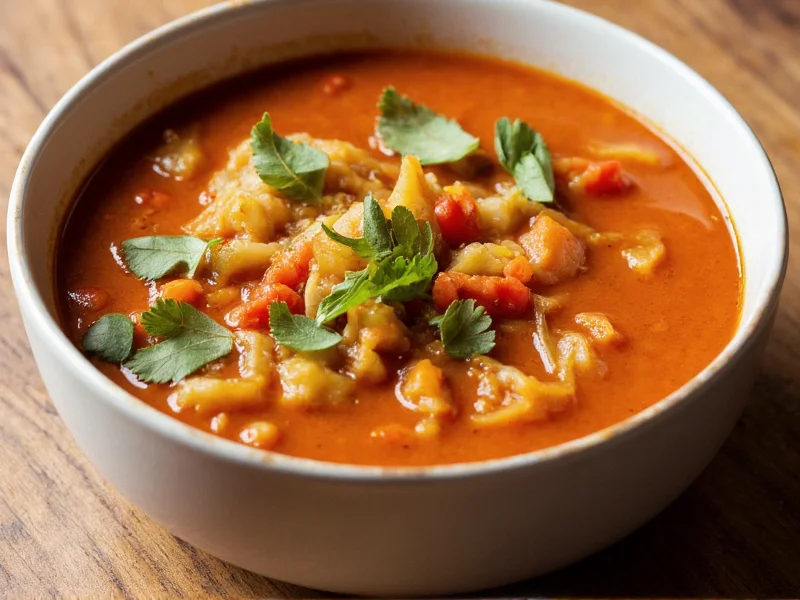What Makes This Soup Uniquely Mediterranean
Unlike dense, meat-heavy cabbage soups from Eastern Europe, authentic Mediterranean cabbage soup emphasizes freshness and simplicity. The Mediterranean approach uses minimal ingredients that highlight seasonal produce. Key differentiators include:
- Generous use of extra virgin olive oil instead of animal fats
- Finish with fresh lemon juice for brightness
- Aromatic herbs like oregano and parsley rather than paprika
- Tomatoes as a base ingredient providing natural acidity
- Light vegetable or chicken broth rather than meat stock
- Optional addition of white beans for plant-based protein
Nutritional Powerhouse: Health Benefits Explained
Mediterranean cabbage soup delivers impressive nutritional benefits that align with the renowned Mediterranean diet. Cabbage itself contains vitamin C, vitamin K, and fiber, while the supporting ingredients create a synergistic health profile.
| Nutrient | Per Serving | Health Benefit |
|---|---|---|
| Vitamin C | 60% DV | Boosts immunity and skin health |
| Vitamin K | 85% DV | Supports bone health and blood clotting |
| Dietary Fiber | 7g | Promotes digestive health and satiety |
| Antioxidants | High | Reduces inflammation and oxidative stress |
This healthy Mediterranean cabbage soup supports weight management with its low calorie density while keeping you satisfied. The combination of fiber-rich cabbage and protein from optional white beans creates a thermogenic effect that boosts metabolism slightly during digestion.
Authentic Mediterranean Cabbage Soup Recipe
Creating an easy Mediterranean cabbage soup recipe requires quality ingredients and proper technique. This version serves four and takes approximately 45 minutes from start to finish.
Traditional Mediterranean Cabbage Soup Ingredients
- 1 small head green cabbage (about 2 lbs), cored and thinly sliced
- 2 tablespoons extra virgin olive oil
- 1 large onion, finely chopped
- 3 garlic cloves, minced
- 2 carrots, peeled and diced
- 1 celery stalk, finely chopped
- 1 (14.5 oz) can diced tomatoes, no salt added
- 6 cups low-sodium vegetable broth
- 1 teaspoon dried oregano
- 1 bay leaf
- 1 (15 oz) can cannellini beans, rinsed and drained (optional)
- 2 tablespoons fresh lemon juice
- Fresh parsley, chopped for garnish
- Salt and freshly ground black pepper to taste
Step-by-Step Preparation
- Heat olive oil in a large pot over medium heat. Add onions and sauté until translucent (about 5 minutes).
- Add garlic, carrots, and celery. Cook for another 5 minutes until vegetables begin softening.
- Stir in cabbage, tomatoes with their juices, broth, oregano, and bay leaf.
- Bring to a boil, then reduce heat to low. Cover and simmer for 25-30 minutes until cabbage is tender but still retains some texture.
- If using, add rinsed cannellini beans during the last 10 minutes of cooking.
- Remove bay leaf. Stir in fresh lemon juice and season with salt and pepper to taste.
- Garnish with fresh parsley before serving.
Perfecting Your Mediterranean Cabbage Soup
Mastering the Mediterranean cabbage soup cooking time ensures optimal texture and flavor. Many home cooks make these common mistakes:
- Overcooking the cabbage - Simmer just until tender-crisp (about 25-30 minutes). Extended cooking creates mushy texture and diminishes nutritional value.
- Adding lemon too early - Acidic ingredients added at the beginning can prevent vegetables from softening properly. Always add lemon juice at the end.
- Using low-quality broth - The broth forms the soup's foundation. Homemade or high-quality store-bought broth makes a significant difference.
- Skipping the olive oil finish - A drizzle of premium extra virgin olive oil just before serving enhances flavor absorption.
Variations for Dietary Needs
This versatile traditional Mediterranean cabbage soup adapts well to various dietary requirements:
- Vegan version: Use vegetable broth and ensure all ingredients meet vegan standards
- Gluten-free preparation: Naturally gluten-free when using certified broth
- Protein boost: Add 1 cup cooked chickpeas or white beans
- Spicy variation: Include 1/4 teaspoon red pepper flakes with the herbs
- Low-carb adaptation: Reduce carrots and increase zucchini
Serving Suggestions and Storage
Serve your Mediterranean cabbage soup with lemon hot with these traditional accompaniments:
- Fresh crusty whole-grain bread for dipping
- Simple green salad with lemon vinaigrette
- Olives and feta cheese on the side
Store leftovers in an airtight container in the refrigerator for up to 4 days. The flavors deepen when allowed to rest overnight. Freeze portions for up to 3 months—thaw in the refrigerator before reheating gently on the stove. Avoid boiling when reheating to preserve the fresh lemon flavor.
Why This Soup Deserves Regular Rotation
This Mediterranean cabbage soup for weight loss offers more than just low calories. The combination of fiber-rich vegetables and healthy fats from olive oil creates sustainable fullness. Unlike restrictive diets, this soup provides complete nutrition while aligning with Mediterranean diet principles proven to support heart health and longevity. The how to make Mediterranean cabbage soup process teaches valuable cooking techniques applicable to many other vegetable-based dishes, making it an excellent foundation recipe for healthy cooking.











 浙公网安备
33010002000092号
浙公网安备
33010002000092号 浙B2-20120091-4
浙B2-20120091-4